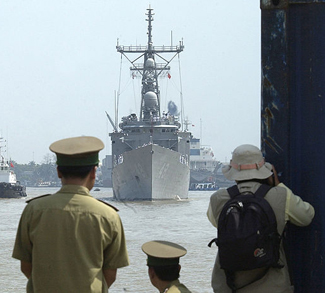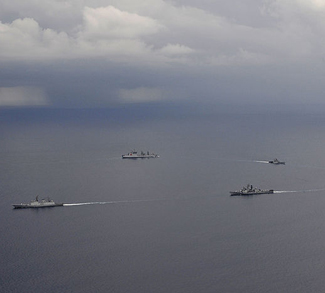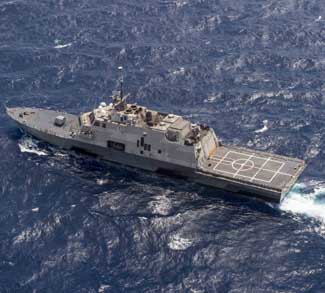In October 2016, U.S. Admiral John Richardson, Chief of Naval Operations, advocated in a ground-breaking article the demise of A2/AD (Anti-Access/Area Denial) as a stand-alone term. According to him, the term became so widely used that it had lost any kind of empiricist accuracy. Not only have international observers become more shy in using the acronym since then, but one could also argue that A2/AD does not fit the evolving security situation in the South China Sea (SCS) anymore, where it was extensively used in the first place.
Vietnam used to be a flagship of area denial strategy in practice. With maritime claims clashing directly with China’s ones in the South China Sea, most notably in the Paracel and Spratley islands, Vietnam became a major East Asian security flashpoint over the past few years. The equation is simple, but its solution difficult: China is a bigger, richer, and more populous country, whose challenging behaviors threaten Vietnam’s interests. Consequently, Vietnam chose to balance against its neighbor. In 2013, some observers boldly announced Vietnam’s adoption of A2/AD strategy when the first of a six-strong fleet of Kilo-class attack submarines was delivered to Hanoi. Four years later, as the sixth and last submarine recently arrived at Cam Ranh harbor, what can be said of Vietnam’s conventional deterrence strategy?
From a national defense perspective, area denial should be divided into two different slices: conventional and non-conventional threats. The Vietnam People’s Navy’s capabilities were boosted by the acquisition of six Kilo submarines. The Russian-manufactured model, with its midship positioned sonars and anti-detection tiles, is designed to track and neutralize enemy-vessels. This costly $2 billion acquisition (SIPRI) is aimed at countering conventional threats at sea and, in case of conflict, compensating for at least a limited period of time the clear asymmetry between the Vietnamese and Chinese navies. In other words, Hanoi upgraded its conventional deterrence by severely raising the cost of conflict at sea for any potential opponent.
Such perspective is actually the most extreme and unlikely outcome. Military analysts are rather concerned by the emergence of more deceitful forms of warfare. The multiplication of so-called “blue-boats,” akin to militias at sea, short-circuits traditional interstate conflict management by intruding sovereign waters and harassing locals. China admittedly operates a fully-fledged fleet of blue-boats in order to, in its own words, “defend [its] sovereignty.” Blue-boats’ armament and training, though far below conventional navies, can sometimes reach significant levels, and their assumed ties to governments are frequently purposely unclear. Put more bluntly, blue-boats in the South China Sea dispute are aimed at spoiling one’s neighbor’s life by disturbing its fishing activities and shipping lines, redefining entirely the concept of conflict.
Vietnam’s answer to that threat is hidden in the details. It is only back in 2013 that Vietnam’s Marine Police was officially rebranded “Coast Guard” and started to play a bigger role in Hanoi’s security policy. An organizational overhaul, implementing regional commands, and steady investments were aimed at reinforcing Vietnam’s South China Sea monitoring capabilities and law-enforcement. Transnational threats such as piracy and smuggling conveniently justify the development of a Vietnamese coast-guard force, and broaden Hanoi’s military cooperation perspectives.
New political orientations participate in Vietnam’s balancing strategy by favoring interdependencies with regional and international partners. This issue might seem remote from area denial strategy, but both aspects are complementary. During his recent visit in Hanoi, Japan’s Prime Minister Shinzo Abe agreed with his Vietnamese counterpart Nguyen Xuan Phuc on developing Japanese investments into Vietnam, increasing development aid loans, and supplying six brand-new patrol ships to the Vietnamese Coast Guard. This long-awaited delivery will help Vietnam to increase its monitoring capabilities in the South China Sea and to counter non-conventional threats.
No third country expects to change Vietnam into a buffer state against China. After all, the so-called “three-nos” policy still officially shape Vietnam’s strategy: no military alliance, no foreign bases, and no reliance on a third party. But A2/AD still makes sense in the minds of the United States, Japan, or India. Hence the recent pouring in defense cooperation agreements and arms supplies destined at reinforcing Vietnam’s territorial sovereignty. The Pentagon provides training to Vietnam through its Maritime Security Initiative, designed to increase Southeast Asian nations’ maritime awareness. India might deliver Akash sol-air missiles to Vietnam in a move openly aimed at containing China, after having agreed to train Hanoi’s fleet of Sukhoi-30s.
What lies ahead in the South China Sea dispute is still unclear. The July 2016 PCA arbitration on China’s claims in the SCS, triggered by the Philippines, was not the milestone expected by partisans of international law. The tribunal declared indeed that the Chinese claims had no legal ground, but Manila reversed its course when the pro-China Rodrigo Duterte won the presidential election in May 2016. Since then, Mr Duterte’s government has been very unclear regarding how to transform the arbitral award into political gains. Vietnamese leaders are resolutely silent about the award anyway, only mildly professing their wish to see international law respected.
The US presidential race and the victory of Donald Trump did nothing to simplify this ambiguous balance. Rex Tillerson, the hawkish secretary of state nominee, declared on January 11 that the United States will “make sure [to] defend international territories from being taken over by one country” in the South China Sea, provoking directly China’s position in the region. In contrast, Vietnam’s Communist Party Secretary General, Mr Nguyen Phu Trong, visited China on January 12-15, promising to President Xi Jinping a renewal of their bilateral relations, most notably, and strikingly, concerning the South China Sea dispute.
It is easy to accuse Vietnam to play smoke and mirrors in its maritime dispute with China. But it would be ignoring the situation’s inherent complexity. Hefty investments in naval and missile capabilities have ensured Vietnam’s A2/AD credibility. But these capabilities increasingly suffer from the same irrelevance as the term itself. With the passing of time, it becomes clear that Hanoi’s core interests reside in ensuring its fishing and shipping security, more than in preparing to counter a phantasmagoric all-out Chinese attack by sea.
The trick is, such threats to civilian activities are still emanating from state-actors, most notably China. Investing in surveillance and law-enforcement is therefore a convenient way to increase one’s presence at sea while skirting accusations of brinkmanship. It is why the future of Vietnam’s area-denial strategy is to be found in its ability to monitor and answer non-conventional threats as well as developing bilateral positive-sum relations with anyone having an interest in preserving the geopolitical balance in the South China Sea.




![By U.S. Navy photo by Photographer’s Mate 2nd Timothy Smith [Public domain], via Wikimedia Commons By U.S. Navy photo by Photographer’s Mate 2nd Timothy Smith [Public domain], via Wikimedia Commons](https://www.geopoliticalmonitor.com/wp-content/uploads/2016/05/US_Navy_040728-N-8796S-093_Vietnamese_military_officials_watch_as_USS_Curtis_Wilbur_DDG_54_prepares_to_moor_in_the_Vietnamese_port_of_Da_Nang.jpg)